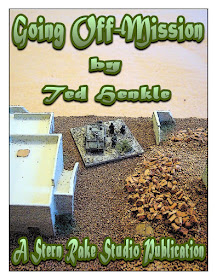 |
| (Image found on Tarleton's Quarter Wargaming Blog) |
I have a small mystery on my hands and I'm searching for answers.
Some years back, I won a couple of bids on E-Bay for a bunch of painted World War II German micro-armor and 1990's American micro-armor. As it turned out, my windfall was part of an estate sale. I get a unsettling, yet pleasant feeling every time I handle these figures from a gamer who's passed on. Which by the way, have a far superior paint job than anything I can accomplish in this earthly life.
While attaining artistic excellence is a mystery to me, it's not the subject of this post.
Also included with the miniatures were two sets of handmade wooden counter blocks. I packed these away, and didn't give them a close examination until I was doing some re-organization of my miniatures and boardgames several days ago.
The first set are generic pieces representing infantry, cavalry artillery and leaders. The set is unequally divided into three factions, which I'll call Yellow, Red and White. These blocks are smooth wood (pine?) and measure about 1 1/4 inches square by 1/4 inch thick.
First, the small Yellow and Red Faction:
The Yellow Faction consists exclusively of cavalry, with two leaders (LDR), organized into two divisions. First Division is the smallest, comprised of 1st CAV and 2nd CAV; while the Second Division is made up of 1st CAV, 1st BDE and 2nd BDE. The brigade counters are half-black half-yellow, which I'll assume to be heavy cavalry.
Meanwhile the Red Faction is comprised entirely of infantry, divided into five divisions, containing one to two brigades.
And then there's the large White Faction:
This sizable force consists of four cavalry units (brigades?), two (heavy?) cavalry brigades, 10 artillery batteries and 10 infantry brigades unevenly divided into five divisions. There's a leader for each division, along with a II Corps LDR and an Army LDR.
There are no numerical values on any of these blocks, but from the unit symbols I'm assuming they fall within the general "Horse & Musket Era."
There are 54 duplicate pieces of various 1st & 2nd BDEs for the five White Faction divisions. I'm not sure if this was deliberate or an oversight on the creator's part.
I'm certain the collection is incomplete, but this isn't what's so puzzling. I haven't seen a game using playing pieces this large, and they're not quite thick to stand on their sides like GMT's Block Games. I think these were intended for either battlefield hidden movement, or to represent miniature units on a campaign map. A very large map.
The second set of counters is even more puzzling.
These counters are larger, but thinner than the first set, measuring 1 1/2 inches square, by 1/8 inch thick. They're painted blue or green to represent Napoleonic French or Russian units, respectively.
Here's a sample of the various Russian troop types and headquarters elements:
While I can identify the unit symbols, it's the number system that I find so baffling.
Here's some Russian cavalry:
There doesn't seem to be a consistent pattern to the number system. Most units have a number in each corner, while some have three numbers along the top separated by dashes, along with a percentage rating in the lower left corner.
However, with the artillery units...
...the numbers on the lower left corner with the hashtags probably indicate the size of the guns. In the above case, 12-pounders, and 6-pounders, respectively.
Some units of the same type also have a different color scheme.
With the Russian cavalry, the counters are either white & yellow, or white & black. (Light and heavy cavalry?).
There's a similar color differentiation with infantry units.
Russian infantry units come with white, green, or yellow unit symbols, with the majority being white. My guess on this is the colored unit symbols denote elite troops.
Russian headquarters units are in three different styles...
...with armies being named, while others (corps?) have Roman or Arabic numerals.
There are no named-leaders in this collection.
I'm wondering if the values on the counters are based on a boardgame. If so, it's not a system I'm familiar with. But these counters are even larger than the first set, so the map would have to be huge.
Or these counters could be used in lieu of miniatures.
I'm hoping someone out there in cyberspace will see this post, recognize the game system and give me a clue on how to utilize these pieces.
The French counters are similarly formatted.
French army and corps headquarters:
Field headquarters:
Various artillery units:
I'm not sure if there's any significance between the red and green symbols. The black dots with gold lettering appear to be Imperial Guard units.
Infantry:
Like the Russian infantry, I think the color differentiation indicates elite status, with blue being veteran troops and the alternating white-blue being Imperial Guard.
Cavalry:
I didn't find any white-green cavalry units among the Russians. That doesn't mean there aren't any--I just haven't found any yet.
Hopefully, I'll make good use of these someday without needlessly getting rid of them, or altering them.
 |
| (Image: by Wojciech Kossak, found on Art of the Russias blog) |




























